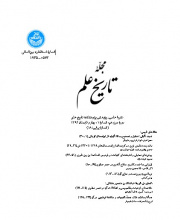۱.
کلید واژه ها:
کیمیا جابر بن حیان الریاض الکبیر
الریاض الکبیر منسوب به جابر بن حیان، بنا به مقدمه مؤلف یکی از آثار مهم برای ورود به صناعت کیمیا است. باب ششم این اثر به معرفی محلول های اسیدی و بازی مختلف، شیوه تولید و اثرات آن ها اختصاص دارد.در این مقاله روش جابر در ساخت محلول ها از باب ششم الریاض الکبیر، ترجمه، و در حد امکان بررسی و تحلیل، و فرمول ها، خواص مواد واکنش دهنده و محصولات آزمایش های جابر بیان می شود.
۲.
کلید واژه ها:
تقویم کوشیار گیلانی زیج جامع
نخستین فصل از مقاله اول زیج جامع، رساله نجومی مهم کوشیار گیلانی، اخترشناس ایرانی که حدود 10 قرن پیش می زیست، به مبحث تقویم اختصاص دارد. در این فصل کوشیار انواع تقویم های شناخته شده در زمان خود، ویژگی های آن ها و چگونگی تبدیل آن ها به یکدیگر را بیان می کند. ویرایشی از یک ترجمه فارسی کهن این فصل، همراه با مقدمه و توضیحات در این مقاله آورده می شود.
۳.
کلید واژه ها:
کاشانی جیب یک درجه قاضی زاده
در بیان استخراج جیب یک درجه رساله ای است به زبان فارسی از مصنفی ناشناس که ظاهراً به منظور تقریر و توضیح روش محاسبه جیب (سینوس) یک درجه بر اساس شرح قوشچی (د. 879 ق) بر زیج الغ بیگ (فارسی) و رساله فی استخراج جیب درجه واحده (عربی) اثر قاضی زاده (د. حدود 840 ق) تالیف شده است. اثری که مبدع اصلی این روش، غیاث الدین جمشید کاشانی (د. 832 ق)، در این باره نوشته، تاکنون به دست نیامده، اما اثر قاضی زاده که در واقع تحریری است از روش کاشانی، در نسخه هایی متعدد برجای مانده است. قوشچی نیز بدون ذکر نام کاشانی، روش وی را شرح می دهد.
۴.
کلید واژه ها:
اسفزاری آثار علوی
رساله آثار علوی ابوحاتم اسفزاری (د. ح. 506-513 ق دربردارنده برخی از دیدگاه های ارسطو (384-322 ق.م) است که در روایت عربی آثار علوی وی دیده نمی شود؛ زیرا ابن بطریق، پدیدآورنده روایت عربی این اثر، برخی جاهای کتاب را ترجمه نکرده و در ترجمه برخی جاهای دیگر نیز خطاهایی شگرف مرتکب شده است. اسفزاری همچنین به نکاتی اشاره می کند که در هیچ یک از دو روایت یونانی و عربی نیامده است. از این رو به نظر می رسد وی افزون بر بهره گیری از این ترجمه مخدوش، به منابع دیگری که به نحوی با روایت اصلی کتاب ارسطو مرتبط بوده اند، دسترسی داشته است. احتمالاً یکی از این منابع، رساله الآثار المخیله فی الجو الحادثه عن البخار المائی ابن خمار (زاده 331ق) بوده است. آثاری که بعدها دانشمندان ایرانی در این باره نوشتند، به نحوی چشمگیر از آثار علوی اسفزاری تاثیر پذیرفته است.
۵.
This article is devoted to two theorems on tangent circles, which were discovered by the Iranian geometer Abu Sah?l Kuhi (fourth century H.). The two theorems were inspired by the Book of Lemmas (makhudhat) attributed to Archimedes. Kuh?'s original treatise is lost, but the two theorems are found in Nas??r al-D? nTu?s?'s edition of the Lemmas of Archimedes. They then appeared in Latin translations in 1659 in London and again in 1661 in Florence, and in 1695 in a revised Dutch version in Amsterdam. The present article compares the original Arabic version of Kuh?'s theorems (in the presentation of T?us?) with the revised Dutch version.
۶.
It is generally recognised that ‘zero’ as we understand the concept today originated in two geographically separated cultures: the Maya and Indian. However, if zero merely signified a magnitude or a direction separator (i.e. separating those above the zero level from those below the zero level), the Egyptian zero, nfr, dating back at least four thousand years, amply served these purposes. If zero was merely a place-holder symbol, indicating the absence of a quantity at a specified place position, then such a zero was present in the Babylonian positional number system before the first recorded occurrence of the Indian zero. If zero was represented by just an empty space within a well-defined positional number system, such a zero was present in Chinese mathematics a few centuries before the beginning of the Common Era. The Indian culture from an early time showed interest and even fascination for large numbers and there is no contrary evidence to indicate that this was not so in the Mayan cultures. The dissemination westwards of the Indian zero as an integral part of the Indian numerals is one of the most remarkable episodes in the history of mathematics and the story is well-known.
۷.
The Islamic astronomy including the Persian astronomy was thoroughly introduced into India from the 14th century AD or so. Firstly, the astrolabe was introduced at the time of F?r?z Sh?h Tughluk?, and a Sanskrit work entitled Yantra-r?ja (1370 AD) was composed by Mahendra S?ri. At that time, some Sanskrit astronomical (or astrological) works were also translated into Persian. The astrolabe became quite popular in India, and Padman?bha wrote the second Sanskrit work on the astrolabe in 1423 AD. During the Delhi Sultanate period and the Mughal Empire period, Islamic astronomy and Hindu Classical astronomy influenced each other. I would like to discuss the introduction of the astrolabe into India and the development of astronomy in India in this period.
